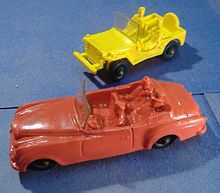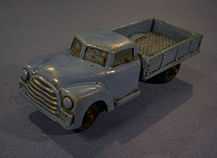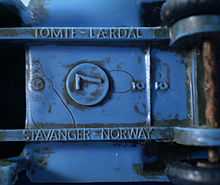Laerdal
- For the municipality of Lærdal, Norway, see Lærdal.

Laerdal is a major manufacturer of medical equipment and medical training products based in Stavanger, Norway. Established in 1940 as a print shop, it soon began manufacturing popular rubber toys under the name Tomte Laerdal - the company's best-known product in the 1960s. Parallel to this was the manufacture of medical training models and devices - the company's mainstay today. Laerdal's best-known product today is a training manikin popularly named 'CPR Annie'.
Tomte Laerdal Toys
The company was started in 1940 by Aasmund Sigurd Laerdal in Stavanger, Norway.[1] Originally a small publishing house, it specialized in greetings cards and children's books. By 1943, the company had expanded into the manufacturing of wooden toys under the name Smavare Industry.

In 1951, the company expanded into plastics and began manufacturing realistic play dolls and later produced "furniture friendly" toy cars under the name Tomte Laerdal.[2] These were similar in concept to cars made by the Auburn Rubber Company in the United States or Galanite of Sweden, though the Galanite products sometimes appeared more realistic and promotional in detail and approach. The first series included an Opel, a Volkswagen, and a Mercedes 190 roadster, which are quite collectible today. Other models included a Studebaker pickup, a Renault Floride sports car, a Volkswagen transporter pickup and others.
In many cases, like the 1960 Chevrolet El Camino, the Tomte toys seem to have been recycled dies previously created by Corgi Toys and Dinky Toys for their 1:43 scale diecast metal vehicles produced in the 1960s in Great Britain. These toys, however, were cast in rubber. Many models and scales were produced, but three to four inch vehicles were the most common.
Alternatively, Tomte Laerdal toys were at times marketed in different countries under different names. Around 1968, a company called Creative Playthings from Priceton, New Jersey, marketed Tomte cars (apparently unchanged) simply as 'Mini-Cars' (Citroen DS 2007-2012).

Tomte rubber cars were very popular. Over 100 million were sold in over 110 countries. They were produced through 1978.
Rubber Medical Supplies
Besides toys, the company expanded its line of products to include realistic wound simulations and other rubber first aid materials. Laerdal's CPR training manikin 'Resusci Anne' is widely used throughout the world. In the US it is called 'CPR Annie', since it serves as the main training tool for modern (mouth-to-mouth method) CPR. 'Resusci Anne' was developed by Peter Safar and Asmund Laerdal, with contributions by James Elam. The face of Resusci Anne was reportedly modeled on the death mask of an unidentified late 19th-century Parisian girl who apparently committed suicide by jumping into the Seine. Asmund S. Laerdal was in possession of a reproduction of the death mask at the time of the manikin's development.[3][4]

In the 1960s the company expanded to include a line of portable medical equipment for ventilation and airway control. Early portable defibrillation devices were offered in the 1980s for use by ambulance personnel. In 1980, the Laerdal Foundation for Acute Medicine was founded. It has supported a variety of research, education and publication projects. 'Stiffneck' collars were added in the 1990s. Medical Plastics Laboratories, Inc., was acquired by Laerdal in January 2000, and renamed Laerdal Texas. Its flagship product is 'SimMan', a computer-controlled patient simulator mannequin. In 2003, Danish-based Sophus Medical was acquired (as Laerdal Sophus), adding a line of interactive medical training products. The acquisition of SimQuest in 2004 (now Laerdal DC), began a line of virtual reality products such as 'IV Arm'. The company's therapy product line was enhanced with the acquisition of STI in 2003, offering spinal immobilization systems.
References
- ↑ Laerdal Company Website
- ↑ Tomte Toys
- ↑ The Girl from the River Seine retrieved from the Laerdal website on January 8, 2013.
- ↑ CPR Annie retrieved from the Snopes.com website on November 7, 2006.
Citroen DS Museum. 2007-2012. Flickriver photo museum. The Martin Boersma Citroen DS collection.